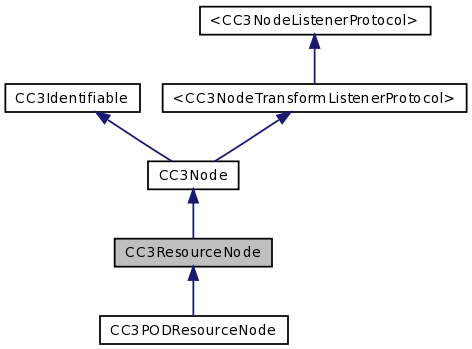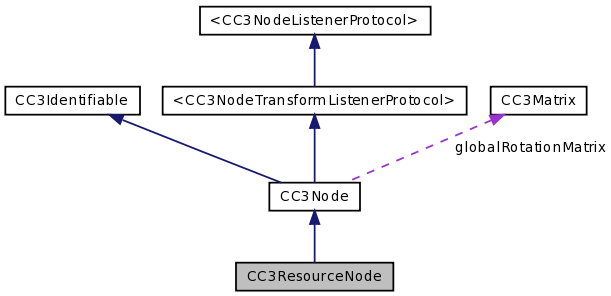A CC3ResourceNode is a CC3Node that that wraps an instance of CC3Resource in the resource property, extracts the nodes from that resource, and forms the root of the resulting node structural assembly. More...
#import <CC3ResourceNode.h>


Public Member Functions | |
| (id) | - initFromFile: |
| (id) | - initFromResourceFile: |
| (id) | - initWithName:fromFile: |
| (id) | - initWithName:fromResourceFile: |
| (void) | - loadFromFile: |
| (void) | - loadFromResourceFile: |
| (Class) | - resourceClass |
Static Public Member Functions | |
| (id) | + nodeFromFile: |
| (id) | + nodeFromResourceFile: |
| (id) | + nodeWithName:fromFile: |
| (id) | + nodeWithName:fromResourceFile: |
Properties | |
| BOOL | expectsVerticallyFlippedTextures |
| CC3Resource * | resource |
Detailed Description
A CC3ResourceNode is a CC3Node that that wraps an instance of CC3Resource in the resource property, extracts the nodes from that resource, and forms the root of the resulting node structural assembly.
The underlying CC3Resource instance can either be set directly, or subclasses can override the resourceClass property to allow the resource property to be lazily created when it is first accessed.
Once this resource node contains a resource, this resource node can be loaded using the loadFromFile: method.
As shortcuts, for subclasses that override the resourceClass property, there are also several class and instance initialization methods for this class that will load the file automatically during instance initialization.
However, before using any of these shortcut methods, you should take into consideration whether you need to set the the expectsVerticallyFlippedTextures property prior to loading, as explained here.
Under iOS, a texture whose width and height are not each a power-of-two, will be converted to a size whose width and height are a power-of-two. The result is a texture that can have empty space on the top and right sides. If the texture coordinates of the mesh do not take this into consideration, the result will be that only the lower left of the mesh will be covered by the texture.
In addition, the vertical axis of the coordinate system of OpenGL is inverted relative to the iOS view coordinate system. This results in textures being displayed upside-down, relative to the OpenGL coordinate system.
The contained CC3Resource will automatically adjust the meshes to compensate for this. Meshes loaded by this resource loader will have their texture coordinates adjusted to align with the usable area of an NPOT texture, and to vertically flip a texture that has been loaded upside-down.
To determine whether textures will need to be vertically flipped, the loader needs to know whether or not the meshes have already been flipped (by the 3D editor or file exporter). The expectsVerticallyFlippedTextures property can be set to indicate to the loader whether the texture coordinates have already been flipped. If the value of that property needs to be changed, it should be set before the file is loaded.
When a copy is made of a CC3ResourceNode instance, a copy is not made of the encapsulated CC3Resource instance. Instead, the CC3Resource is retained by reference and shared between both the original CC3ResourceNode, and the new copy.
Member Function Documentation
| - (id) initFromFile: | (NSString *) | aFilepath |
Initializes this instance and, using the contained resource, loads the file at the specified file path, extracts the loaded CC3Nodes from the contained resource, and adds them as child nodes to this resource node.
The specified file path may be either an absolute path, or a path relative to the application resource directory. If the file is located directly in the application resources directory, the specified file path can simply be the name of the file.
The name of this node will be set to that of the resource, which is usually the name of the file loaded.
| - (id) initFromResourceFile: | (NSString *) | DEPRECATED_ATTRIBUTE |
- Deprecated:
- Use the initFromFile: method instead, which supports both absolute file paths and file paths that are relative to the resources directory.
| - (id) initWithName: | (NSString *) | aName | |
| fromFile: | (NSString *) | aFilepath | |
Initializes this instance and, using the contained resource, loads the file at the specified file path, extracts the loaded CC3Nodes from the contained resource, and adds them as child nodes to this resource node.
The specified file path may be either an absolute path, or a path relative to the application resource directory. If the file is located directly in the application resources directory, the specified file path can simply be the name of the file.
The name of this node will be set to the specified name.
| - (id) initWithName: | (NSString *) | aName | |
| fromResourceFile: | (NSString *) | DEPRECATED_ATTRIBUTE | |
- Deprecated:
- Use the initWithName:FromFile: method instead, which supports both absolute file paths and file paths that are relative to the resources directory.
| - (void) loadFromFile: | (NSString *) | aFilepath |
Using the contained resource, loads the file at the specified file path, extracts the loaded CC3Nodes from the contained resource, and adds them as child nodes to this resource node.
The specified file path may be either an absolute path, or a path relative to the application resource directory. If the file is located directly in the application resources directory, the specified file path can simply be the name of the file.
If not already set, the name of this node will be set to that of the resource, which is usually the name of the file loaded.
| - (void) loadFromResourceFile: | (NSString *) | DEPRECATED_ATTRIBUTE |
- Deprecated:
- Use the loadFromFile: method instead, which supports both absolute file paths and file paths that are relative to the resources directory.
| + (id) nodeFromFile: | (NSString *) | aFilepath |
Allocates and initializes an autoreleased instance and, using the contained resource, loads the file at the specified file path, extracts the loaded CC3Nodes from the contained resource, and adds them as child nodes to this resource node.
The specified file path may be either an absolute path, or a path relative to the application resource directory. If the file is located directly in the application resources directory, the specified file path can simply be the name of the file.
The name of this node will be set to that of the resource, which is usually the name of the file loaded.
| + (id) nodeFromResourceFile: | (NSString *) | DEPRECATED_ATTRIBUTE |
- Deprecated:
- Use the nodeFromFile: method instead, which supports both absolute file paths and file paths that are relative to the resources directory.
| + (id) nodeWithName: | (NSString *) | aName | |
| fromFile: | (NSString *) | aFilepath | |
Allocates and initializes an autoreleased instance and, using the contained resource, loads the file at the specified file path, extracts the loaded CC3Nodes from the contained resource, and adds them as child nodes to this resource node.
The specified file path may be either an absolute path, or a path relative to the application resource directory. If the file is located directly in the application resources directory, the specified file path can simply be the name of the file.
The name of this node will be set to the specified name.
| + (id) nodeWithName: | (NSString *) | aName | |
| fromResourceFile: | (NSString *) | DEPRECATED_ATTRIBUTE | |
- Deprecated:
- Use the nodeWithName:FromFile: method instead, which supports both absolute file paths and file paths that are relative to the resources directory.
| - (Class) resourceClass |
Returns the class of the CC3Resource instance used to load 3D data files.
This returned value is used by the initializers that load the file, and must be overridden in a sublcass if those initializers are to be used.
Default implementation triggers and assertion and returns CC3Resource. Subclasses must override.
Property Documentation
- (BOOL) expectsVerticallyFlippedTextures [read, write, assign] |
Indicates whether the texture coordinates of the meshes that will be loaded by the CC3Resource loader expect that the texture will be flipped upside-down during texture loading.
This property is a convenience property that simply gets and sets the same property on the contained CC3Resource instance.
The vertical axis of the coordinate system of OpenGL is inverted relative to the iOS view coordinate system. This results in textures from most file formats being oriented upside-down, relative to the OpenGL coordinate system. All file formats except PVR format will be oriented upside-down after loading.
If the value of this property is YES, the texture coordinates of meshes loaded by the CC3Resource will be assumed to have already been flipped vertically, (typically by the 3D editor or file exporter) to align with textures that will be vertically flipped by the texture loader.
If the value of this property is NO, the texture coordinates of meshes loaded by the CC3Resource loader will be assumed to have their original orientation, and aligned with textures that have not been vertically flipped by the texture loader.
The value of this property is then used to cause the meshes to automatically correctly align themselves with the orientation of any texture applied to them.
For meshes that are based on vertex arrays, this property is used to set the same property on each CC3VertexTextureCoordinates instance created and loaded by this resource. When a texture is assigned to cover the mesh, the value of that CC3VertexTextureCoordinates property is used in combination with the value of the isFlippedVertically property of a texture to determine whether the texture coordinates should automatically be reoriented when displaying that texture.
Implements CC3Node.
- (CC3Resource *) resource [read, write, retain] |
The underlying CC3Resource instance containing the 3D nodes.
Setting this property will remove all child nodes of this CC3ResourceNode and replace them with the nodes extracted from the nodes property of the new CC3Resource instance, if they have already been loaded.
If this node has not yet been assigned a name, it will be set to the name of the resource when this property is set.
If the resource has not already been loaded when it is set here, it may be loaded using the loadFromFile: methods of this resource node instance.
For subclasses of CC3ResourceNode that override the resourceClass property, if this resource property is not explicitly set, it is lazily created, as an instance of the class identified by the resourceClass property, when this resource property is first accessed. Since the resourceClass property depends on the type of resource file format to be loaded, lazy creation of the resource property from the resourceClass property requires the creation of a subclass of CC3ResourceNode that defines the appropriate resourceClass value.
The documentation for this class was generated from the following file:
 1.7.2
1.7.2